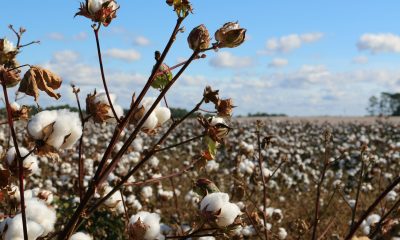Markets
Soybeans and Soybean Meal Closed Lower Last Week on Reports of Increased Offers from South America
Soybean Oil closed a little higher. The weekly export sales report showed less than expected demand for US Soybeans. Reports indicate that China remains an active buyer of Soybeans in Brazil, but might have to cut back on demand if the domestic market does not improve. Brazil basis levels are very strong and US products now compare favorably in price to those from South America.

Wheat: Wheat was lower in all three markets last week as adverse world growing conditions appear to be part of the price now and could be moderating in the next week or so, anyway. Russian analytical services cut production estimates over the weekend to between 80 and 82 million tons, from over 85 million previously. There were no more reports of hot temperatures coming this week to Russian growing areas, but rain ia also now in the forecasts. It has also been very dry there.
In addition, Ukraine sent drones to several Russian ports, including grains ports, to disrupt the export pace and cost Russia money. The weather is still a key, with extreme dryness reported in Russia and parts of the US and too wet conditions reported in Europe. Big world supplies and low world prices are still around. Export sales remain weak on competition from Russia, Ukraine, and the EU as those countries look to export a lot of Wheat in the coming period. Black Sea offers are still plentiful.
Weekly Chicago Soft Red Winter Wheat Futures
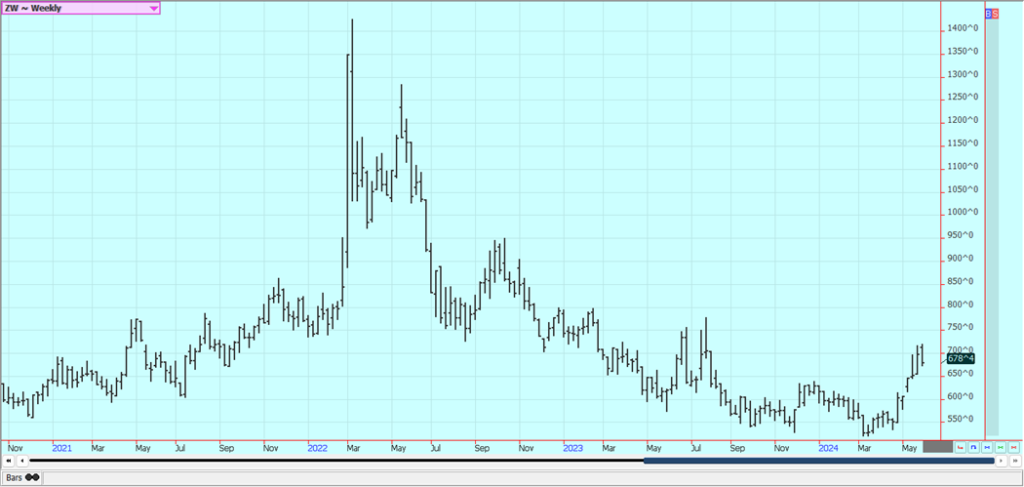
Weekly Chicago Hard Red Winter Wheat Futures
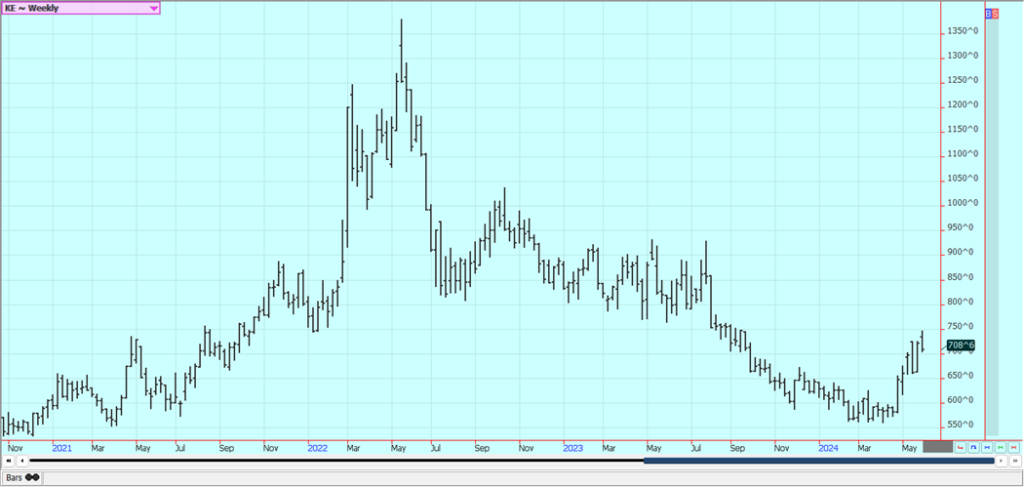
Weekly Minneapolis Hard Red Spring Wheat Futures
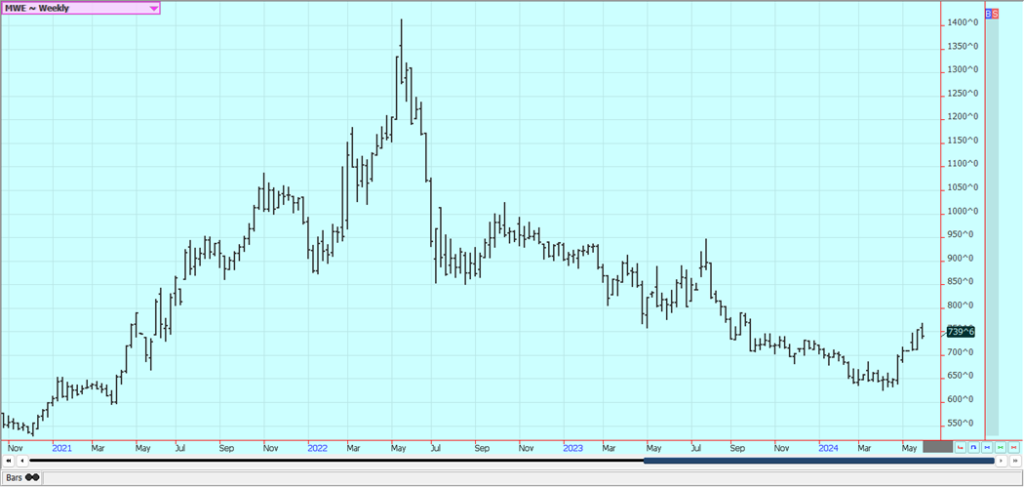
Corn: Corn closed lower last week on forecasts for improved planting weather for the Midwest and on reports of increased competition for export sales from South America as basis levels are reported to be lower in Brazil. Oats were higher. The weather in the Midwest has been very wet and more rain is coming to cause planting delays but to allow for rapid development of planted crops.
The Argentine crop has been hit by stunting disease that robs yields and the Brazil Winter crop is suffering from hot and dry weather, but sellers in both countries are offering. Demand has been the driving force behind the rally. Increased demand was noted in most domestic categories along with rising basis levels, and export demand has been strong. Ethanol demand has turned less due to weaker petroleum prices seen lately. Oats were higher last week.
Weekly Corn Futures
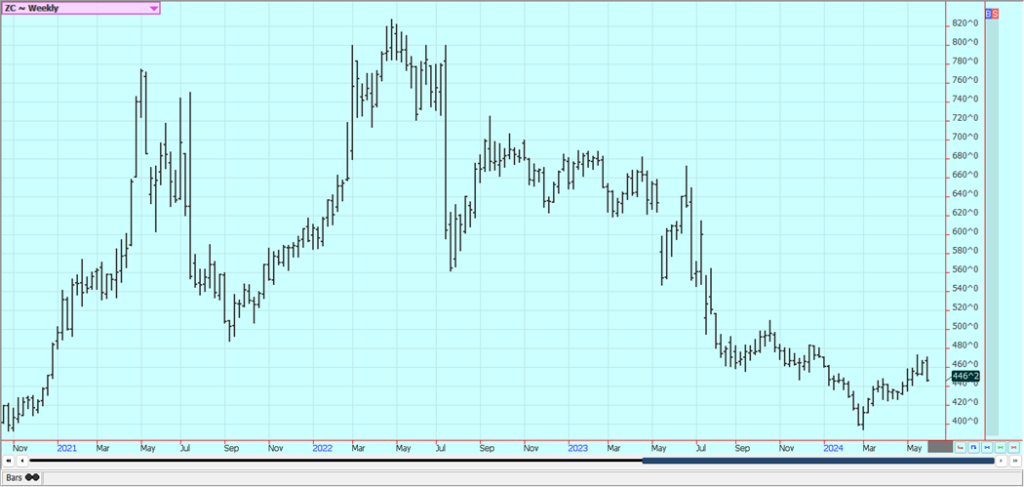
Weekly Oats Futures
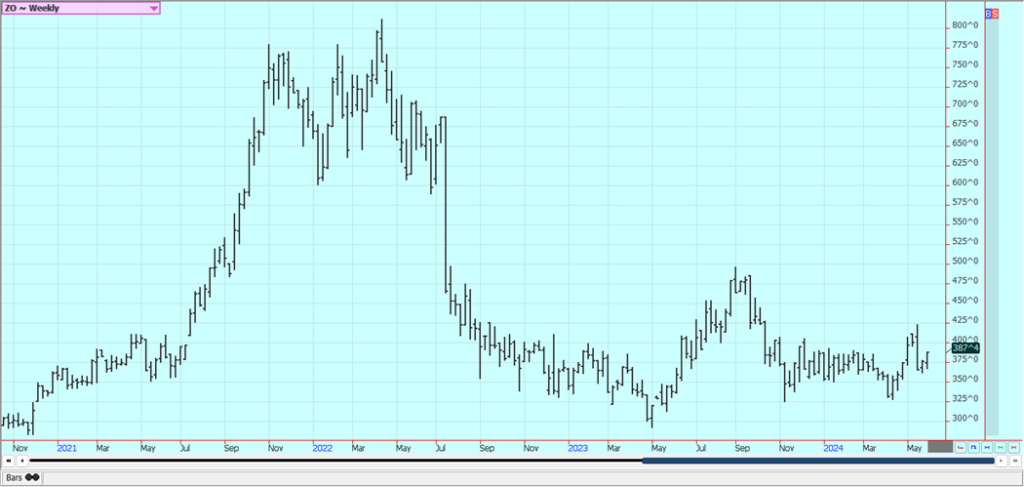
Soybeans and Soybean Meal: Soybeans and Soybean Meal closed lower last week on reports of increased offers from South America. Soybean Oil closed a little higher. The weekly export sales report showed less than expected demand for US Soybeans. There were wire reports that China price are weakening amid veery strong imports from Brazil.
Reports indicate that China remains an active buyer of Soybeans in Brazil, but might have to cut back on demand if the domestic market does not improve. Brazil basis levels are very strong and US products now compare favorably in price to those from South America. Support for Soybeans came from reports of excessive rains falling in US growing areas, especially the eastern sections of the Midwest. Domestic demand has been strong in the US but has suffered as crushers were crushing for oil. Oil demand has suffered as cheaper alternatives for feedstocks hit the bio fuels market.
Weekly Chicago Soybeans Futures
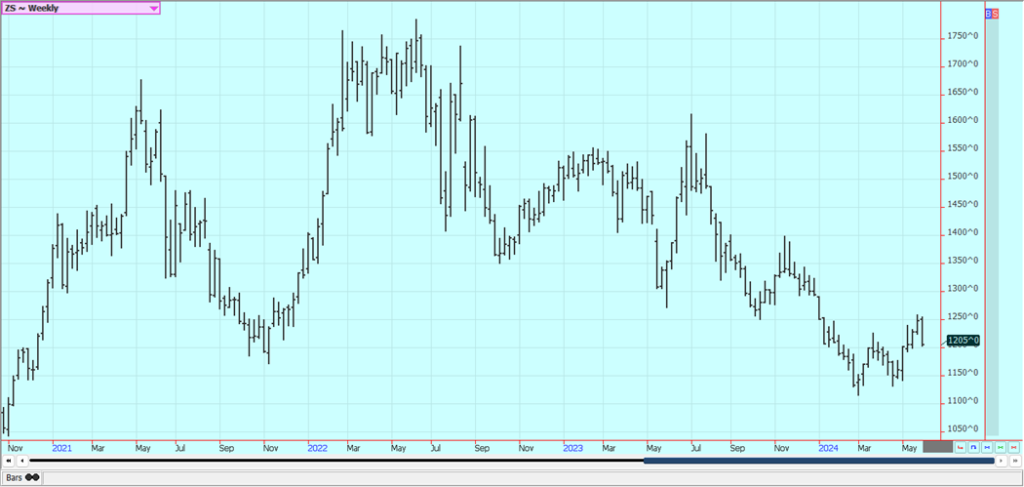
Weekly Chicago Soybean Meal Futures
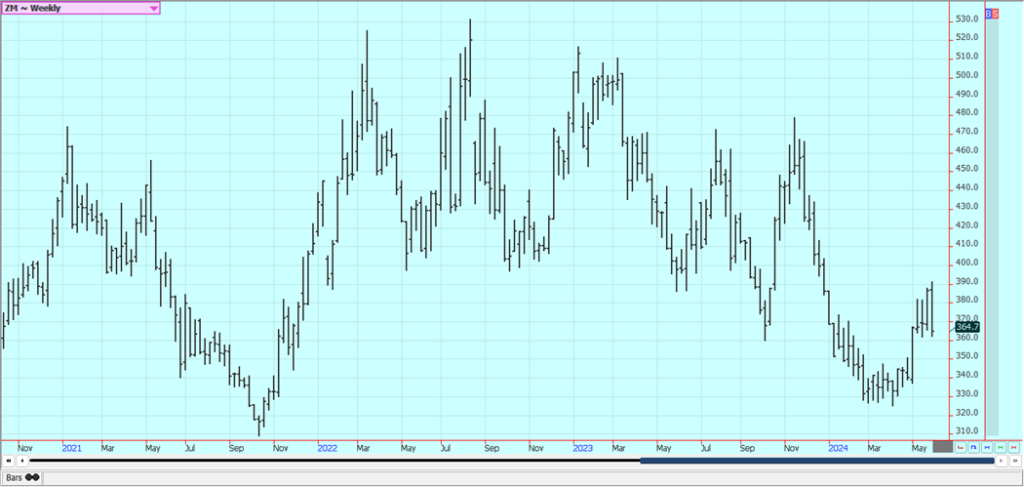
Rice: Rice closed mostly higher last week, but July was lower on speculative selling tied to weaker demand ideas and the weekly charts showed the weakness in July. Most of the weakness was in the front month due to many buyers holding off making purchases until the cheaper new crop Rice becomes available in a few months.
Support comes from adverse weather in South American growing areas while new selling is noted from the potential for a big crop in the US. The big US crops are now in doubt from reports of extreme rains in southern growing areas and especially near Houston. Supply tightness is expected to give way to increased production this year and greatly increased supplies this Fall. These ideas are reflected in the prices seen in the old crop and the new crop. Big storms continue to bring significant and potentially damaging rains to crops in Texas.
Weekly Chicago Rice Futures
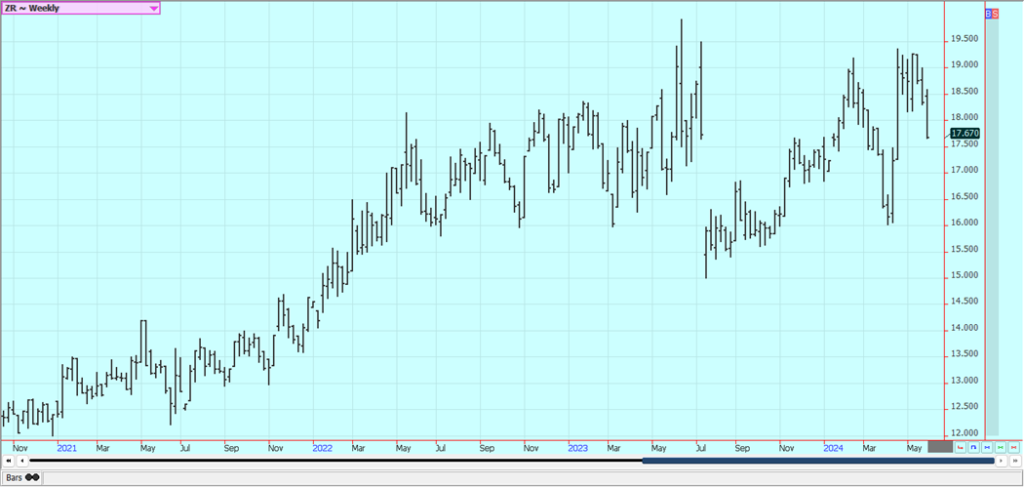
Palm Oil and Vegetable Oils: Palm Oil was higher on ideas of good export demand despite ideas of increasing production. Export demand has been very strong in recent private reports. There is talk of increased supplies available to the market, but the trends are up on the daily and weekly charts. Canola was also lower lasy week on reports of generally good conditions in Canada.
Weekly Malaysian Palm Oil Futures:
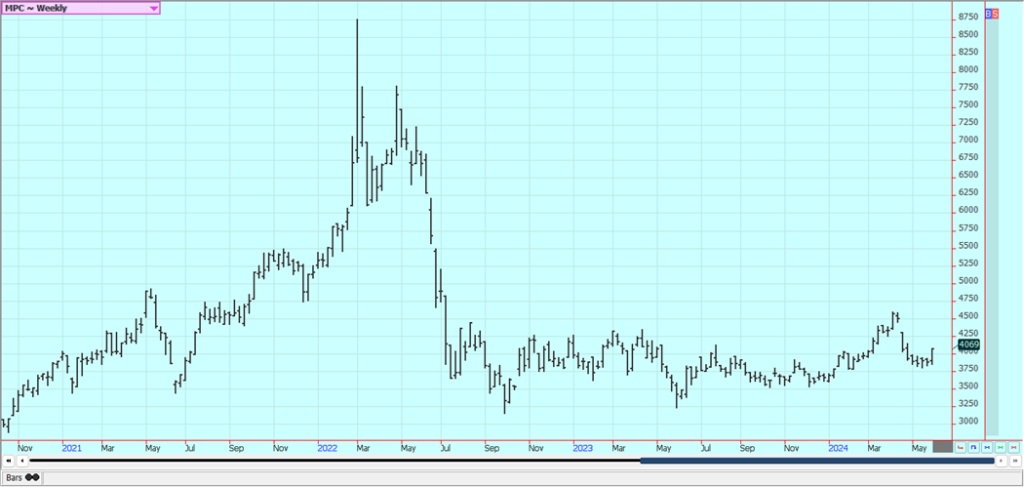
Weekly Chicago Soybean Oil Futures
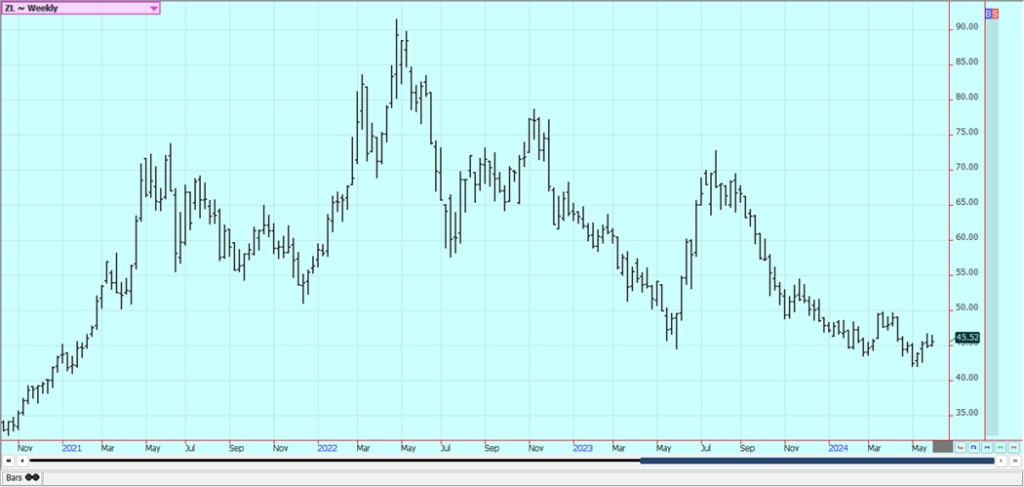
Weekly Canola Futures
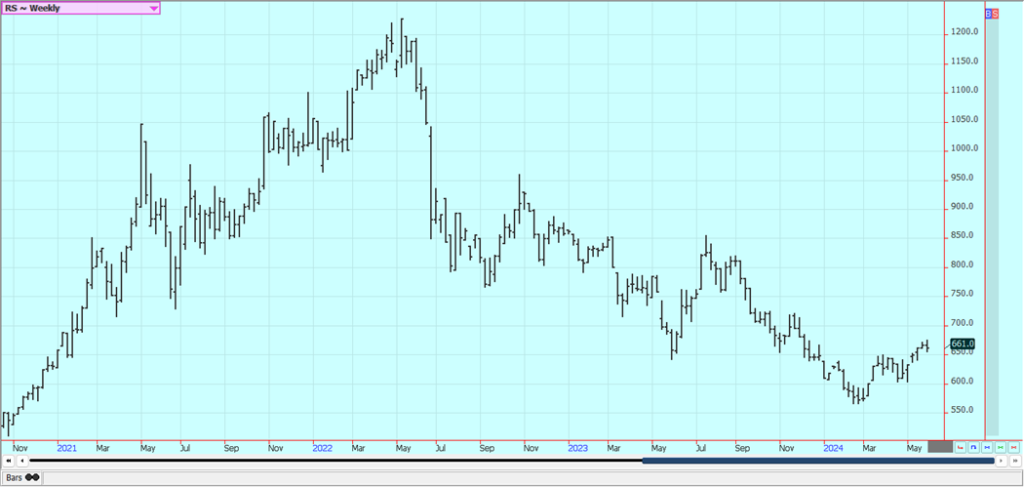
Cotton: Cotton was lower last week and prices are back at the lower end of a trading range despite signs of improving demand. The weekly export sales report showed improving demand for US Cotton. USDA said that 60% of the US crop was rated good to excellent on Tuesday afternoon. The weekly export sales report showed much improved sales last week. Wire reports indicate that speculators were covering short positions.
Big storms are reported in Texas that could damage crops. There are also some big problems with too much rain in the Delta and Southeast in recent days. Demand has been weaker so far this year but there are hopes for improved demand with the lower prices. The US economic data has been positive, but the Chinese economic data has not been real positive and demand concerns are still around. However, Chinese consumer demand has held together well, and demand for Cotton in world markets has started to increase.
Weekly US Cotton Futures
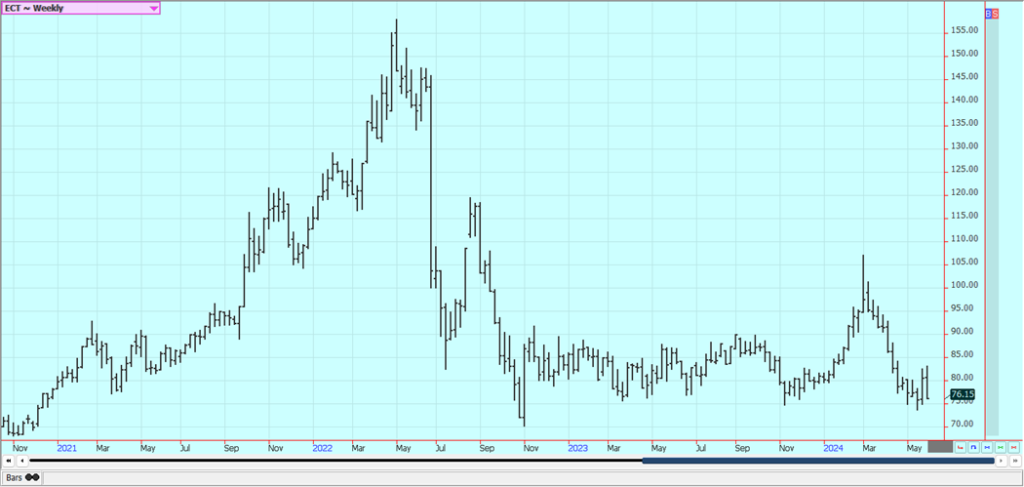
Frozen Concentrated Orange Juice and Citrus: FCOJ closed sharply lower to limit down yesterday on what appeared to be speculative selling tied to profit taking, but the market remains well supported longer term based on forecasts for tight supplies and very hot weather in Florida. The weekly charts show a key reversal down.
Retail prices in May hit a new record high of $9.69 a gallon, 9% higher than last year. The reduced production appears to be at the expense of the greening disease. There are no weather concerns to speak of for Florida or for Brazil right now. The weather has improved in Brazil with some moderation in temperatures and increased rainfall amid reports of short supplies in Florida and Brazil are around but will start to disappear as the weather improves and the new crop gets harvested.
Weekly FCOJ Futures
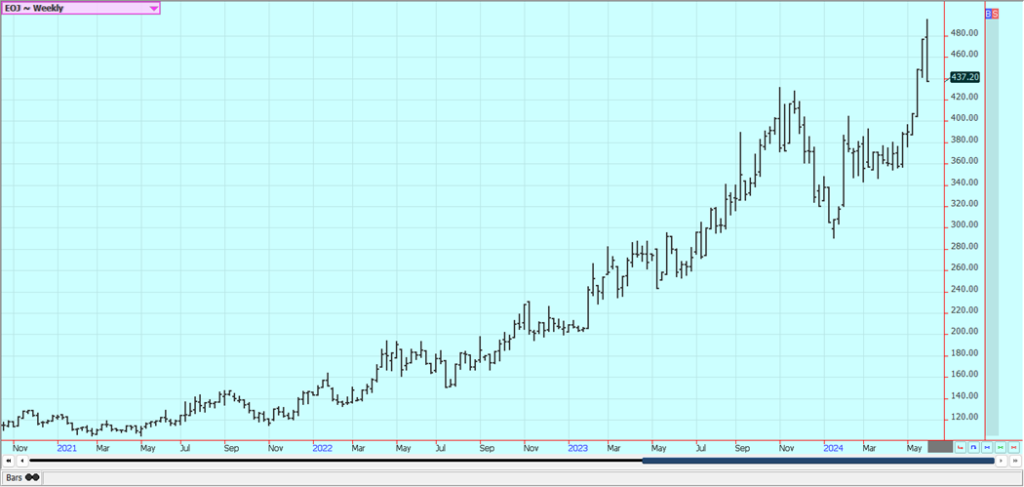
Coffee: New York was a little higher and London closed higher last week on new commercial and speculative trading on ideas of reduced offers of Robusta and on forecasts for another couple of weeks of dry weather in Vietnam. Much of the weekly gains were given back on Friday, but the close was still positive. There were also reports of poor Robusta yields in Brazil during the harvest.
Weekly chart tends turned up with the price action, while the price action on Friday left daily charts showing mixed trends. Ideas of less production in Vietnam are driving the rally. There were indications that Brazil and Vietnam producers were now offering Coffee, buts in small amounts, Vietnamese producers are reported to have about a quarter of the crop left to sell or less and reports indicate that Brazil producers are reluctant sellers for now after selling a lot earlier in the year. Exports from Brazil have remained strong.
Weekly New York Arabica Coffee Futures
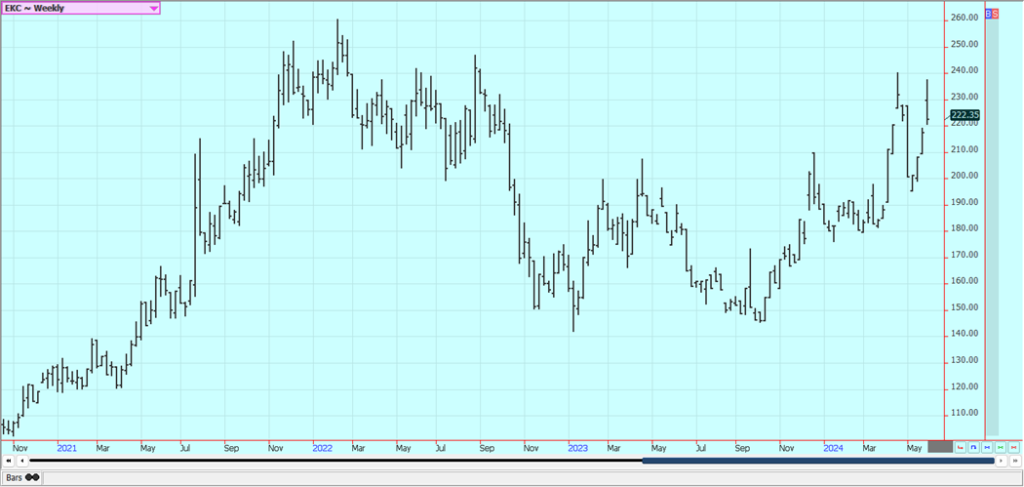
Weekly London Robusta Coffee Futures
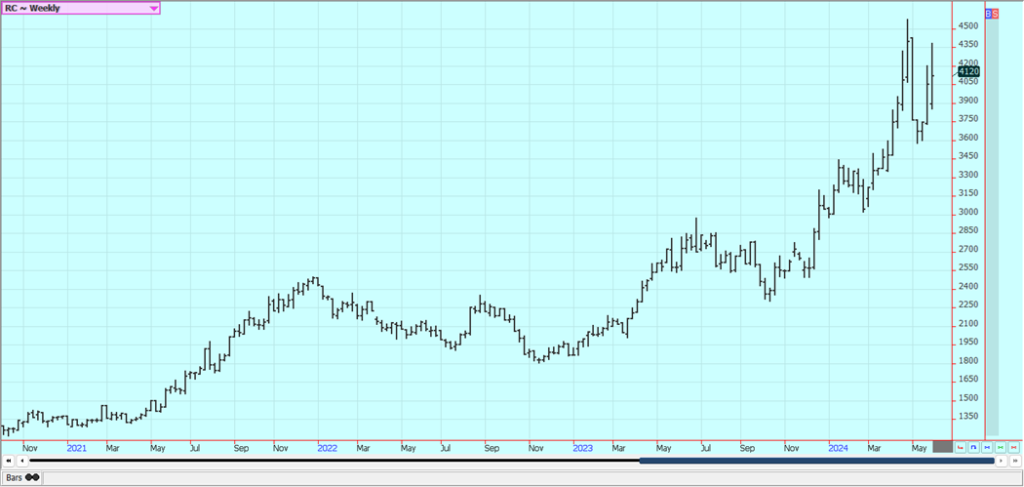
Sugar: Both markets closed a little lower last week and the charts show that both markets remain in a trading range. There are still ideas that the Brazil harvest can be strong for the next few weeks amid dry harvest weather. Harvest weather is called good in center-south Brazil. There are worries about the Thai and Indian production, but data shows better than expected production from both countries. Offers from Brazil are still active.
Weekly New York World Raw Sugar Futures
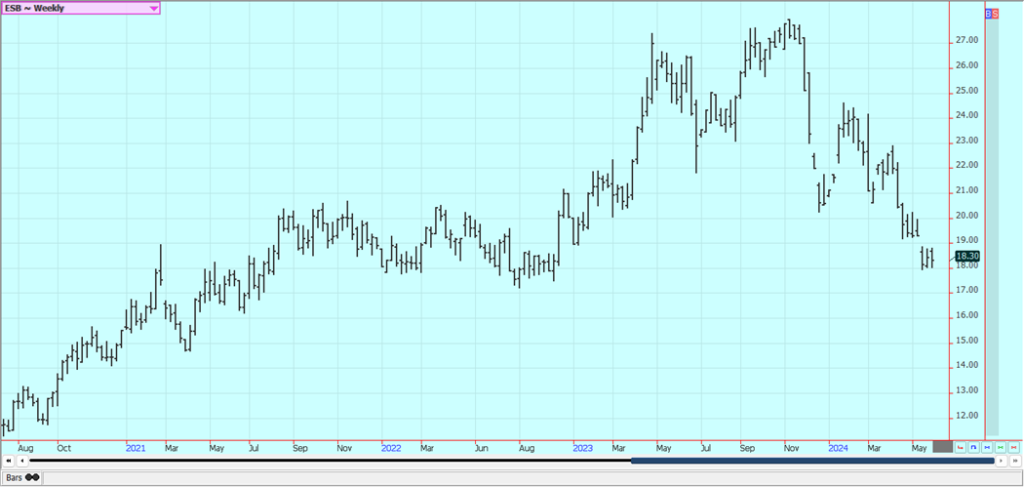
Weekly London White Sugar Futures
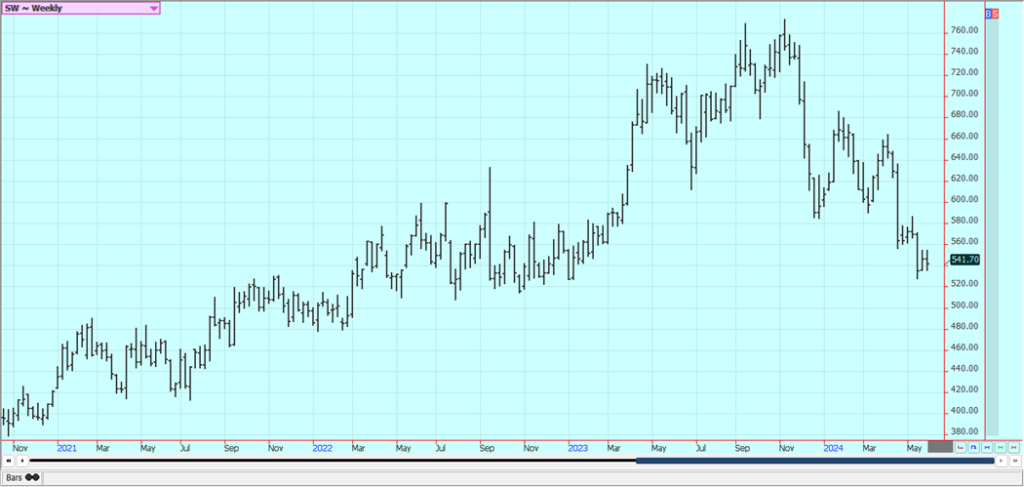
Cocoa: Both markets were higher last week and trends are up for the short term on what appeared to be some speculative short covering. Production concerns in West Africa as well as demand from non-traditional sources along with traditional buyers keep supporting futures. Production in West Africa could be reduced this year due to the extreme weather which included Harmattan conditions.
The availability of Cocoa from West Africa remains very restricted and projections for another production deficit against demand for the coming year are increasing. Ideas of tight supplies remain based on more reports of reduced arrivals in Ivory Coast and Ghana continue. Mid crop harvest is now underway and here are hopes for additional supplies for the market from the second harvest. Demand continues to be strong, especially from traditional buyers of Cocoa.
Weekly New York Cocoa Futures
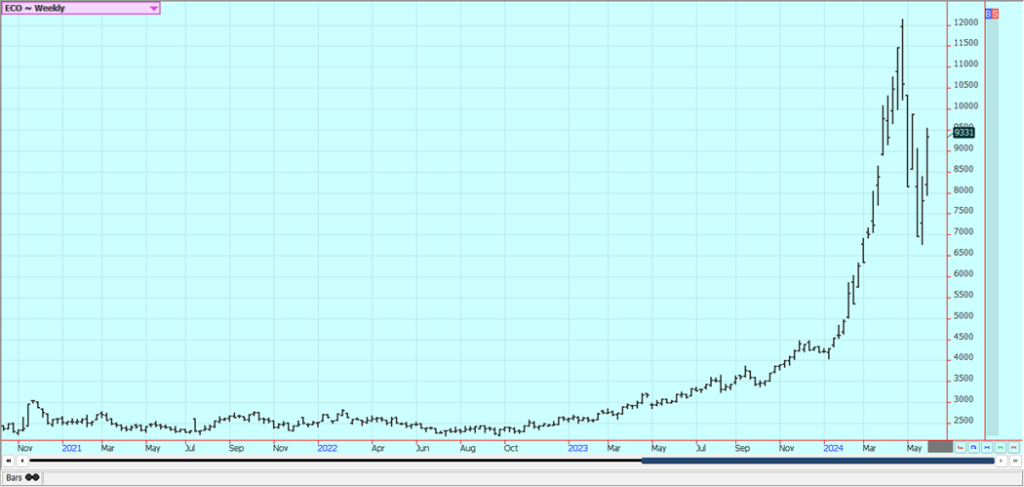
Weekly London Cocoa Futures
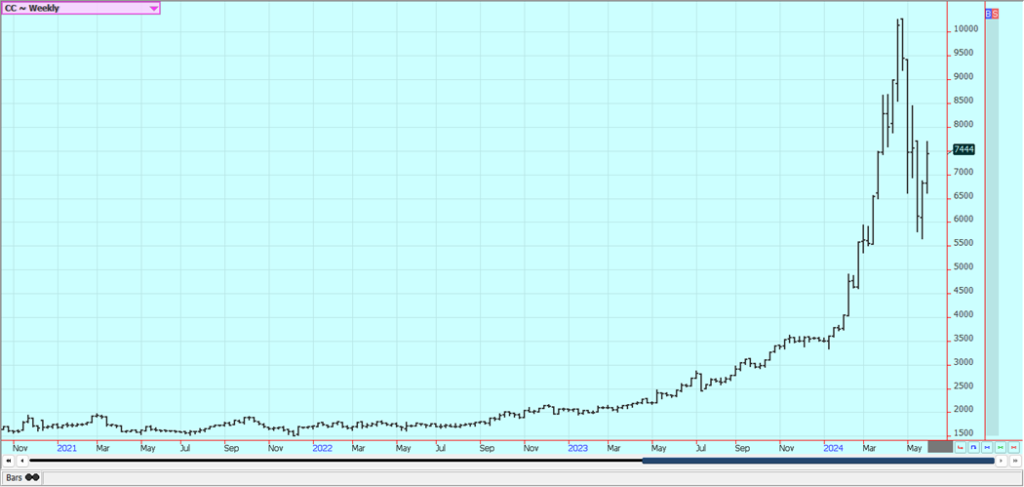
__
(Featured image by Donnie Rosie via Unsplash)
DISCLAIMER: This article was written by a third party contributor and does not reflect the opinion of Born2Invest, its management, staff or its associates. Please review our disclaimer for more information.
This article may include forward-looking statements. These forward-looking statements generally are identified by the words “believe,” “project,” “estimate,” “become,” “plan,” “will,” and similar expressions. These forward-looking statements involve known and unknown risks as well as uncertainties, including those discussed in the following cautionary statements and elsewhere in this article and on this site. Although the Company may believe that its expectations are based on reasonable assumptions, the actual results that the Company may achieve may differ materially from any forward-looking statements, which reflect the opinions of the management of the Company only as of the date hereof. Additionally, please make sure to read these important disclosures.
Futures and options trading involves substantial risk of loss and may not be suitable for everyone. The valuation of futures and options may fluctuate and as a result, clients may lose more than their original investment. In no event should the content of this website be construed as an express or implied promise, guarantee, or implication by or from The PRICE Futures Group, Inc. that you will profit or that losses can or will be limited whatsoever.
Past performance is not indicative of future results. Information provided on this report is intended solely for informative purpose and is obtained from sources believed to be reliable. No guarantee of any kind is implied or possible where projections of future conditions are attempted. The leverage created by trading on margin can work against you as well as for you, and losses can exceed your entire investment. Before opening an account and trading, you should seek advice from your advisors as appropriate to ensure that you understand the risks and can withstand the losses.

-

 Impact Investing2 weeks ago
Impact Investing2 weeks agoEU Expands Leadership in Sustainable Finance with Record Green Bond Impact
-

 Impact Investing6 days ago
Impact Investing6 days agoEU End-of-Life Vehicles Rule Pushes Cars Toward a Circular Economy
-

 Crowdfunding2 weeks ago
Crowdfunding2 weeks agoFlower Burger Launches Crowdfunding to Fuel Growth in Booming Plant-Based Market
-

 Business4 days ago
Business4 days agoTopRanked.io Weekly Affiliate Digest: What’s Hot in Affiliate Marketing [1xBet + FIFA World Cup]


